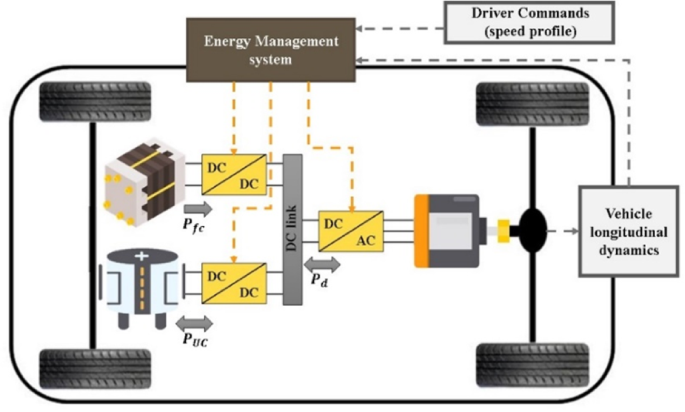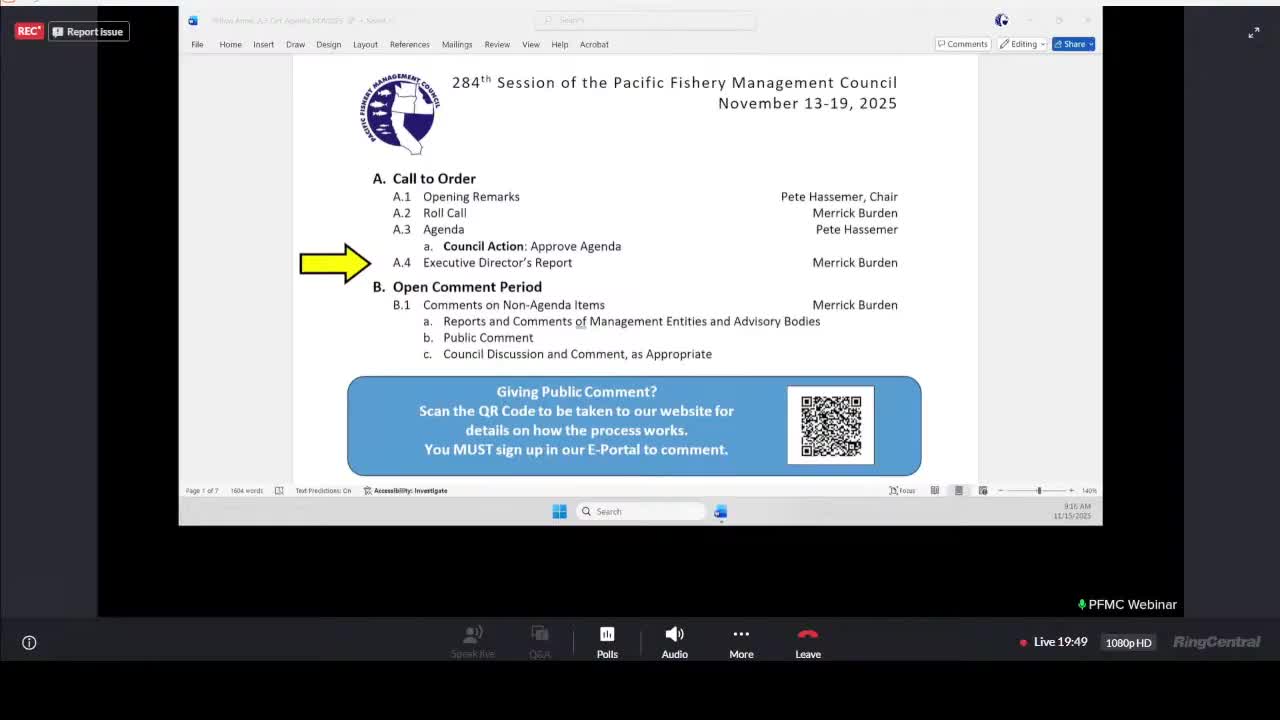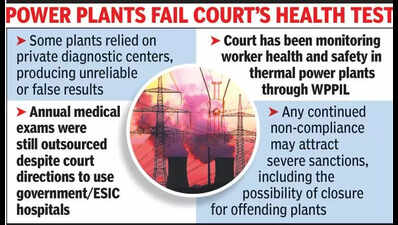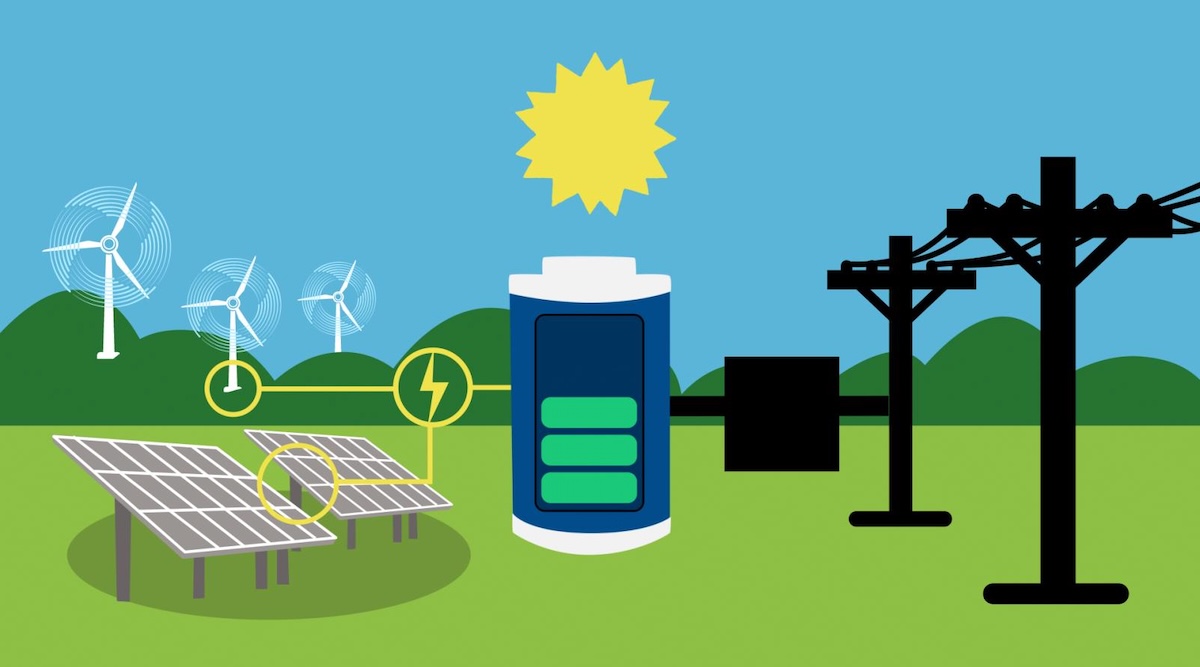A robust energy management strategy for fuel cell and ultracapacitor hybrid electric vehicles under uncertainty via a jellyfish-search-based approach – Nature

Executive Summary
This report details the development of a robust Energy Management System (EMS) for a Fuel Cell Hybrid Electric Vehicle (FCHEV), designed to advance key Sustainable Development Goals (SDGs). The system optimizes a powertrain comprising a fuel cell (FC) and an ultracapacitor (UC), addressing critical gaps in previous research which often prioritized hydrogen consumption at the expense of component longevity. By integrating multiple objectives, this work directly contributes to SDG 12 (Responsible Consumption and Production) by extending the lifespan of both FC and UC components. The proposed EMS utilizes the Jellyfish Search (JS) optimizer, an innovative algorithm selected for its rapid convergence, which supports SDG 9 (Industry, Innovation, and Infrastructure) by enabling efficient real-time decision-making. To ensure resilience against real-world operational uncertainties such as road conditions and component aging, a robust optimization (RO) framework was implemented. Simulation results under varied driving cycles confirm the system’s effectiveness. The JS-based EMS demonstrates superior performance, maintaining system constraints and reducing severe power fluctuations in the fuel cell, thereby enhancing durability. The RO-enhanced system successfully met 100% of power demand even under uncertainty, proving its viability as a reliable technology for advancing SDG 7 (Affordable and Clean Energy) and SDG 11 (Sustainable Cities and Communities) through dependable, clean transportation.
Introduction: Aligning Automotive Technology with Sustainable Development Goals
The global imperative to address climate change and resource depletion, central to the Sustainable Development Goals, necessitates a transition towards renewable and green energy sources. This transition is critical in the transportation sector, a major contributor to air pollution and greenhouse gas emissions. This report examines the role of Fuel Cell Hybrid Electric Vehicles (FCHEVs) as a key technology in achieving several interconnected SDGs:
- SDG 7 (Affordable and Clean Energy): FCHEVs utilize hydrogen, a clean energy carrier, offering a zero-emission alternative to fossil fuels and contributing to a sustainable energy future.
- SDG 11 (Sustainable Cities and Communities): By replacing internal combustion engine (ICE) vehicles, FCHEVs directly mitigate urban air pollution, creating healthier and more sustainable urban environments.
- SDG 13 (Climate Action): The adoption of hydrogen-powered vehicles is a direct action to reduce the carbon footprint of transportation and combat climate change.
While FCHEVs present a promising alternative to battery electric vehicles (BEVs) by overcoming challenges such as long charging times and battery recycling issues, their widespread adoption hinges on optimizing performance and durability. A critical component for achieving this is an advanced Energy Management System (EMS). The EMS must intelligently manage power flow between the fuel cell and an energy storage system, such as an ultracapacitor, to meet fluctuating power demands efficiently. This research proposes an innovative EMS that not only minimizes fuel consumption but also actively manages component health, thereby promoting SDG 12 (Responsible Consumption and Production) by maximizing resource efficiency and product lifespan. By developing a robust and intelligent control system, this work contributes to SDG 9 (Industry, Innovation, and Infrastructure), fostering the technological advancements needed for a sustainable transportation infrastructure.
Methodology for Sustainable Energy Management
System Modeling for FCHEV
The FCHEV system model consists of a primary power source (Proton Exchange Membrane Fuel Cell) and an auxiliary energy storage system (Ultracapacitor). This hybrid configuration is designed to leverage the high energy density of the fuel cell for sustained power and the high power density of the ultracapacitor for transient loads and regenerative braking. This design inherently supports SDG 12 by protecting the fuel cell from damaging power fluctuations, thereby extending its operational life. The modeling accounts for key operational parameters and potential sources of uncertainty, including:
- Power Demand Uncertainty: Variations in road conditions (drag and rolling friction coefficients) and motor efficiency due to aging.
- Power Converter Uncertainty: Fluctuations in the efficiency of DC/DC converters and inverters.
- Power Generation Uncertainty: Degradation of fuel cell efficiency due to temperature, stress, and aging.
Acknowledging these uncertainties is crucial for developing a system that is not only efficient but also reliable and resilient, a cornerstone for building the sustainable infrastructure envisioned in SDG 9.
Energy Management System (EMS) Framework
The core objective of the EMS is to orchestrate the power distribution between the fuel cell and the ultracapacitor to meet vehicle power demand while achieving specific sustainability targets. The framework is designed as a multi-objective optimization problem that seeks to:
- Minimize hydrogen consumption, directly supporting SDG 7 by improving energy efficiency.
- Preserve the State of Charge (SoC) of the ultracapacitor within optimal limits to ensure system responsiveness and longevity.
- Limit the rate of change in the fuel cell’s power output to prevent degradation, a key factor for SDG 12.
This holistic approach ensures that the vehicle operates not just cleanly, but also economically and durably over its entire lifecycle.
Optimization Approach: Jellyfish Search (JS) Algorithm
To solve the multi-objective optimization problem in real-time, this study employs the Jellyfish Search (JS) algorithm. JS is a metaheuristic optimizer inspired by the food-searching behavior of jellyfish. Its selection is a strategic innovation aligned with SDG 9, offering distinct advantages over conventional methods like Particle Swarm Optimization (PSO):
- Faster Convergence: JS demonstrates a superior ability to find optimal solutions with fewer iterations, reducing computational load and making it suitable for online implementation.
- Balanced Exploration and Exploitation: The algorithm effectively explores the solution space to avoid suboptimal local minima, ensuring a globally optimized performance.
The application of JS enables the EMS to make rapid, intelligent decisions that enhance both fuel economy and component health, making FCHEVs a more practical and sustainable transportation solution.
Robust Optimization for Real-World Conditions
To ensure the FCHEV performs reliably under the unpredictable conditions of real-world driving, a robust optimization (RO) model based on a min-max approach is integrated with the JS algorithm. This framework prepares the system for the worst-case scenarios arising from the identified uncertainties. By optimizing for robustness, the EMS guarantees that performance and safety constraints are met even when component efficiencies degrade or driving conditions become more demanding. This focus on resilience is vital for the deployment of FCHEVs as part of the sustainable and resilient infrastructure targeted by SDG 9 and SDG 11.
Performance Analysis and Results
The proposed EMS was evaluated using two distinct driving cycles, the Extra-Urban Driving Cycle (EUDC) and the Worldwide Harmonized Light Vehicles Test Cycle (WLTC-Class 2), to test its performance under different conditions. The results underscore the system’s contribution to sustainable transportation.
Deterministic Optimization Performance
Under nominal conditions without uncertainties, the JS-based EMS was compared against a PSO-based system. The findings clearly demonstrate the superiority of the JS algorithm for this application.
- System Stability and Longevity (SDG 12): The JS optimizer maintained smooth fuel cell power output, avoiding the harmful oscillations observed with PSO. Stress analysis revealed that JS significantly reduced the occurrences of severe power changes, thereby minimizing stress on the fuel cell and contributing to a longer system lifespan.
- Efficiency and Innovation (SDG 7 & 9): The JS algorithm achieved optimal performance with a lower computational time (reductions of 5.5% for EUDC and 6.7% for WLTS) and a 100% Demand Satisfaction (DS) rate. In contrast, the PSO-based system failed to meet power demand in the WLTC cycle (90.8% DS), highlighting its sub-optimality for real-time control.
Robust Optimization Performance under Uncertainty
When subjected to worst-case scenarios with multiple uncertainties, the robust JS-based EMS demonstrated exceptional resilience.
- Reliability for Sustainable Infrastructure (SDG 9 & 11): The robust EMS successfully met 100% of the perturbed power demand across both driving cycles. In contrast, the deterministic (non-robust) EMS failed, achieving only 91.35% DS. This confirms the robust model’s ability to ensure reliable vehicle operation, a prerequisite for public trust and adoption in sustainable urban transport systems.
- The Cost of Resilience (SDG 12): This enhanced reliability comes at a calculated trade-off. The Cost of Robustness (CR) was an increase in hydrogen consumption of 10.8% for EUDC and 11.17% for WLTC. This marginal increase in fuel use is a justifiable cost for guaranteeing system performance and safety, ensuring the vehicle remains functional and efficient throughout its lifecycle, which aligns with responsible production and consumption principles.
Conclusion: Advancing Sustainable Transportation through Robust EMS
This report has successfully demonstrated an advanced, optimization-based EMS for FCHEVs that directly supports the UN Sustainable Development Goals. By employing the innovative Jellyfish Search (JS) optimizer, the system achieves superior performance over conventional methods, enhancing fuel efficiency while simultaneously extending component lifespan. This dual focus is a critical step towards fulfilling SDG 7 (Affordable and Clean Energy) and SDG 12 (Responsible Consumption and Production).
Furthermore, the integration of a robust optimization framework ensures that the vehicle can operate reliably in the face of real-world uncertainties. This resilience is paramount for building the dependable, clean transportation infrastructure required for SDG 9 (Industry, Innovation, and Infrastructure) and SDG 11 (Sustainable Cities and Communities). While robustness entails a modest increase in hydrogen consumption, it is a necessary trade-off to guarantee the safety and performance essential for widespread adoption. The developed EMS represents a significant technological advancement, paving the way for FCHEVs to play a pivotal role in the global transition to a sustainable, low-carbon future and in taking direct Climate Action (SDG 13).
Analysis of Sustainable Development Goals (SDGs) in the Article
1. Which SDGs are addressed or connected to the issues highlighted in the article?
-
SDG 7: Affordable and Clean Energy
The article directly addresses this goal by focusing on the development of energy systems for “fuel cell hybrid electric vehicles (FCHEVs).” The introduction explicitly states that exploring “new alternative sources of energy” like fuel cells is motivated by the depletion of fossil fuels. Reference [1] in the article is titled “…identifying the key contributors to affordable & clean energy (SDG-7),” directly linking the research to this goal. The entire paper is centered on making clean energy technology for transport more efficient and reliable.
-
SDG 9: Industry, Innovation, and Infrastructure
This goal is relevant as the paper presents a significant technological innovation—a “robust energy management system (EMS)” using a novel “Jellyfish Search (JS) optimizer.” This work contributes to upgrading the technological capabilities of the automotive industry by developing more sophisticated, efficient, and resilient systems for clean vehicles. The research aims to create a more sustainable industrial technology by improving the performance and lifespan of FCHEV components.
-
SDG 11: Sustainable Cities and Communities
The article connects to this SDG by addressing a key problem in urban areas: air pollution. The introduction states that vehicles with internal combustion (ICE) engines are “one of the main causes of the persistent problem of air pollution.” By developing and improving clean transportation technologies like FCEVs, the research contributes to reducing the negative environmental impact of cities and improving urban air quality.
-
SDG 13: Climate Action
This goal is addressed through the article’s focus on technologies that mitigate climate change. The text highlights that hydrogen, the fuel for the vehicle, is “eco-friendly and has nearly zero greenhouse gas (GHG) emissions.” The shift from fossil fuel-based transportation to hydrogen-powered vehicles is a direct action to combat climate change by reducing emissions from a major sector.
2. What specific targets under those SDGs can be identified based on the article’s content?
-
SDG 7: Affordable and Clean Energy
- Target 7.2: By 2030, increase substantially the share of renewable energy in the global energy mix. The development of FCHEVs promotes the use of hydrogen as an energy carrier, which can be produced from renewable sources, thereby increasing the share of clean energy in the transport sector.
- Target 7.3: By 2030, double the global rate of improvement in energy efficiency. The primary objective of the proposed Energy Management System (EMS) is to “minimize the hydrogen consumption,” which directly translates to improving the energy efficiency of the vehicle.
- Target 7.a: By 2030, enhance international cooperation to facilitate access to clean energy research and technology… and promote investment in energy infrastructure and clean energy technology. This research paper itself is a contribution to the global body of knowledge on clean energy technology, facilitating its advancement.
-
SDG 9: Industry, Innovation, and Infrastructure
- Target 9.4: By 2030, upgrade infrastructure and retrofit industries to make them sustainable, with increased resource-use efficiency and greater adoption of clean and environmentally sound technologies and industrial processes. The proposed EMS is an advanced, clean technology designed to make the automotive industry more sustainable by improving the efficiency and longevity of FCHEVs.
- Target 9.5: Enhance scientific research, upgrade the technological capabilities of industrial sectors in all countries… encouraging innovation. The paper’s core contribution is the development and testing of a novel optimization algorithm (Jellyfish Search) and a robust optimization model for a complex engineering problem, which is a direct example of enhancing scientific research and technological capabilities.
-
SDG 11: Sustainable Cities and Communities
- Target 11.6: By 2030, reduce the adverse per capita environmental impact of cities, including by paying special attention to air quality and municipal and other waste management. The article’s motivation is to replace polluting internal combustion engine vehicles, which are a major source of urban air pollution. The adoption of the proposed FCHEV technology would directly contribute to better air quality in cities.
-
SDG 13: Climate Action
- Target 13.2: Integrate climate change measures into national policies, strategies and planning. The development of zero-emission vehicle technology is a key strategy and measure that can be integrated into national plans to meet climate goals. This research supports the technological feasibility of such measures.
3. Are there any indicators mentioned or implied in the article that can be used to measure progress towards the identified targets?
-
SDG 7: Affordable and Clean Energy
- Hydrogen Consumption: The article explicitly formulates the optimization problem to minimize hydrogen consumption (CH2). The results show an increase in hydrogen consumption of 10.8% and 11.17% as the “cost of robustness,” providing a quantifiable measure of energy efficiency under different conditions. This relates to Target 7.3.
- System Efficiency: The paper models the efficiency of various components, such as the fuel cell (ηfc) and converters (ηConv). Improving these efficiencies is a key part of the overall goal and can be measured.
-
SDG 9: Industry, Innovation, and Infrastructure
- Computational Time: The article measures and compares the computational time of the proposed JS optimizer (around 0.15 s) against the PSO algorithm, showing a reduction of 5.5-6.7%. This is a direct indicator of the technological efficiency and feasibility of the innovation for real-time application.
- Lifespan of Components: A stated goal of the EMS is “increasing the life span of system components” by “reducing the occurrences of severe changes in the power demand of fuel cells.” The stress analysis and histograms of power changes (ΔP) serve as indicators for measuring progress toward this goal.
-
SDG 11: Sustainable Cities and Communities
- Greenhouse Gas (GHG) Emissions: While not directly measured in the simulation results, the article’s premise is that hydrogen fuel has “nearly zero greenhouse gas (GHG) emissions.” The adoption of this technology implies a direct reduction in transport-related emissions, which is the key indicator for improving urban air quality (Target 11.6).
-
SDG 13: Climate Action
- Demand Satisfaction (DS) Indicator: The article uses the DS indicator to measure the system’s ability to meet power demands, especially under uncertainty. A DS of 100% for the robust model, compared to ~91% for the deterministic one under worst-case scenarios, indicates the technology’s reliability, which is crucial for its adoption as a climate change mitigation strategy.
- Cost of Robustness (CR): This indicator measures the extra energy (hydrogen) required to ensure the system is resilient to real-world uncertainties. It quantifies the trade-off between efficiency and reliability, a key factor in planning for the integration of climate-friendly technologies.
4. Table of SDGs, Targets, and Indicators
| SDGs | Targets | Indicators |
|---|---|---|
| SDG 7: Affordable and Clean Energy |
|
|
| SDG 9: Industry, Innovation, and Infrastructure |
|
|
| SDG 11: Sustainable Cities and Communities |
|
|
| SDG 13: Climate Action |
|
|
Source: nature.com
What is Your Reaction?
 Like
0
Like
0
 Dislike
0
Dislike
0
 Love
0
Love
0
 Funny
0
Funny
0
 Angry
0
Angry
0
 Sad
0
Sad
0
 Wow
0
Wow
0












;Resize=805#)


































































